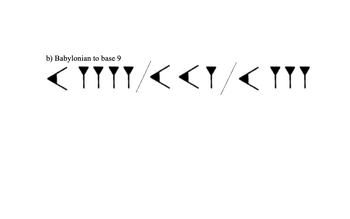
Advanced Engineering Mathematics
10th Edition
ISBN: 9780470458365
Author: Erwin Kreyszig
Publisher: Wiley, John & Sons, Incorporated
expand_more
expand_more
format_list_bulleted
Question

Transcribed Image Text:The image illustrates the conversion of Babylonian numerals into base 9, divided into three sections by slashes. Each section showcases cuneiform symbols representing specific numerical values typical of the Babylonian numeral system, which was sexagesimal (base 60) but is here being contextualized in base 9.
### Babylonian Numerals
The symbols include:
- Wedge-like indentations that represent specific numbers.
- These indentations vary in orientation and number to convey different values.
### Sections and Symbols:
1. **First Section:**
- Contains a leftward wedge followed by four vertical lines.
- In Babylonian numerals, this represents a composite number based on groupings of values.
2. **Second Section:**
- Includes a leftward wedge, two smaller leftward wedges, and a vertical line.
- These combinations form another number or part of a larger numerical expression.
3. **Third Section:**
- Comprises a leftward wedge, a triangle, and two vertical lines.
- Represents another value or sequence to be interpreted in the conversion process.
The task is to interpret these figures into numbers applicable in base 9. Understanding these symbols is crucial for recognizing ancient numerical systems and their significance in historical contexts.
Expert Solution
This question has been solved!
Explore an expertly crafted, step-by-step solution for a thorough understanding of key concepts.
This is a popular solution
Trending nowThis is a popular solution!
Step by stepSolved in 2 steps with 2 images

Knowledge Booster
Similar questions
- 1. a) 105 hours after it reads 2:00? b) 45 hours before it reads 12:00? c) 160 hours after it reads 19:00? What time does a 24-hour clock readarrow_forward2. Convert (BCAA) 14 to base 8.arrow_forwardUsing Euler's Theorem, simplify the following numbers: p=3, q= 5, x = 2, and a = 2. Which of the following answers is accurate? not on 0000 131,072 = 0 (mod 15) 131,070 = 0 (mod 15) 65,536 = 0 (mod 15) 131,070 = 2 (mod 15) adımarrow_forward
- Show how you might sketch base pieces to illustrate each computation by filling out each part of the following questions. Part 1 out of 5 a. 148 + 25 i) Combine sets for a total of flats, longs, and units. ii) Regroup units to longs and units. iii) Regroup longs to flats and longs. iv) There are now flats, longs, and units. v) 148 + 25 =arrow_forwardQ.7) Convert each number to base ten. a. 100101two b ABCDsixteen Q.8) Convert as indicated. a. 49 to binary b. 6748nine to base four.arrow_forward8. Perform each of the following in the indicated base. a) 212three +21three b) 712 eight-145 eight c) 8 hours 32 minutes 38 seconds +3 hours 49 minutes 54 seconds d) 5 hours 16 minutes 24 seconds – 1 hour 28 minutes 48 seconds -arrow_forward
arrow_back_ios
arrow_forward_ios
Recommended textbooks for you
 Advanced Engineering MathematicsAdvanced MathISBN:9780470458365Author:Erwin KreyszigPublisher:Wiley, John & Sons, Incorporated
Advanced Engineering MathematicsAdvanced MathISBN:9780470458365Author:Erwin KreyszigPublisher:Wiley, John & Sons, Incorporated Numerical Methods for EngineersAdvanced MathISBN:9780073397924Author:Steven C. Chapra Dr., Raymond P. CanalePublisher:McGraw-Hill Education
Numerical Methods for EngineersAdvanced MathISBN:9780073397924Author:Steven C. Chapra Dr., Raymond P. CanalePublisher:McGraw-Hill Education Introductory Mathematics for Engineering Applicat...Advanced MathISBN:9781118141809Author:Nathan KlingbeilPublisher:WILEY
Introductory Mathematics for Engineering Applicat...Advanced MathISBN:9781118141809Author:Nathan KlingbeilPublisher:WILEY Mathematics For Machine TechnologyAdvanced MathISBN:9781337798310Author:Peterson, John.Publisher:Cengage Learning,
Mathematics For Machine TechnologyAdvanced MathISBN:9781337798310Author:Peterson, John.Publisher:Cengage Learning,


Advanced Engineering Mathematics
Advanced Math
ISBN:9780470458365
Author:Erwin Kreyszig
Publisher:Wiley, John & Sons, Incorporated

Numerical Methods for Engineers
Advanced Math
ISBN:9780073397924
Author:Steven C. Chapra Dr., Raymond P. Canale
Publisher:McGraw-Hill Education

Introductory Mathematics for Engineering Applicat...
Advanced Math
ISBN:9781118141809
Author:Nathan Klingbeil
Publisher:WILEY

Mathematics For Machine Technology
Advanced Math
ISBN:9781337798310
Author:Peterson, John.
Publisher:Cengage Learning,

